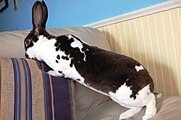
Domestic rabbit
The domestic or domesticated rabbit, commonly known as a pet rabbit, is the domesticated form of the European rabbit, a member of the lagomorph order. A male rabbit is known as a buck, a female is a doe, and a young rabbit is a kit.
This article is about the domesticated form of the European rabbit. For the wild variety, see European rabbit. For all rabbit species, see Rabbit.
Rabbits were first domesticated and used for their food and fur by the Romans, and have been kept as pets in Western nations since the early 1900s.[1] Rabbits can be housed inside but the idea of the domestic rabbit as a house companion, a so-called house rabbit similar to a house cat, was only strongly promoted starting with publications in the 1980s. Rabbits can be litter box-trained and taught to come when called, but they require exercise and can damage a house that has not been "rabbit proofed" based on their innate need to chew. Accidental interactions between pet rabbits and wild rabbits, while seemingly harmless, are usually strongly discouraged due to the species' different temperaments as well as wild rabbits potentially carrying diseases.[2][3]
Unwanted pet rabbits end up in animal shelters, especially after the Easter season (see Easter Bunny). In 2017, they were the United States' third most abandoned pet.[4] Some of them go on to be adopted and become family pets in various forms.[5] Because their wild counterparts have become invasive in Australia, pet rabbits are banned in the state of Queensland.[6] Pet rabbits, being a domesticated breed that lack survival instincts, do not fare well in the wild if they are abandoned or escape from captivity.[2][3]
Besides being used as pets, domesticated rabbits are used as laboratory animals and are farmed as livestock for their meat, wool and fur. Specific breeds are used in different industries; Rex rabbits, for example, are commonly raised for their fur, and the New Zealand rabbit is commonly used in animal testing for its docility and good health.
Terminology[edit]
Male rabbits are called bucks; females are called does. An older term for an adult rabbit is coney, while rabbit once referred only to the young animals.[24] Another term for a young rabbit is bunny, though this term is often applied informally (especially by children and rabbit enthusiasts) to rabbits generally, especially domestic ones. More recently, the term kit or kitten has been used to refer to a young rabbit. A young hare is called a leveret; this term is sometimes informally applied to a young rabbit as well. A group of rabbits is known as a "colony" or a "nest".[25]



